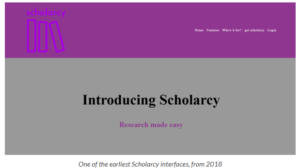Read more“… by far the best support I have had.” – Editor-in-Chief, CUP journal.
Guest Post: Nine rules for a startup
Guest post by Michael Upshall, reposted with his permission.
Phil Gooch, founder of the successful startup Scholarcy, was the highlight of the first-ever AI, Publishing and EdTech Meetup (London, February 2025). Each of the four speakers was allotted 15 minutes, and Phil’s talk was the only one not to include any slides and the only one that was, as he mentioned, a real story. Scholarcy, founded by him and Emma Warren-Jones in 2018, was sold in 2024 to Texthelp, a leading provider of scholarly support tools for higher education. It was, and is, one of the best tools to make use of AI to assist the scholarly research process.


Roughly restated (this was not an event for detailed notes), his nine principles are:
- Something you care about. If you are going to spend all your waking hours on a new business, make sure it is something you really care about. In Phil’s case, it arose from his own PhD study, looking for a better way to summarize and to manage his literature review, rather than using highlighters and PDFs.
- Find a cofounder, with complementary skills. Phil could build tools; Emma could do marketing.
- Be prepared to pivot. Scholarcy’s initial market was selling services to publishers, but this was not sustainable. They switched to selling direct to users, and, fortunately, they had already built an engine, so they only needed a front end. Their second, and equally big pivot, was the discovery that the tools they provide for any student or researcher were equally beneficial for neurodivergent learners, which meant they were able to sell their product in markets where some funding was available.
- Be frugal at the start. They were fortunate to get a small investment, but this was not one of those startups that raises £20m and then burns the lot. In their first year, their total income was £140 – fortunately, the founders were working part-time at this point.
- Create a team. You need a team, and the best recruits are people who come to you. A would-be designer presented them with an entire site redesign, free of charge, and they offered him a job.
- Branding. The next step was to integrate the website and marketing initiatives in a single theme.
- Automation. Make sure you automate your process as soon as possible.
- Organic growth (this applies to a B2C company). They found an SEO guru to get them to the top of the search rankings, and identified new would-be influencers who were mentioning the product without payment.
- Spread the risk. For some years the whole operation was run from a card payment account, rather than a business bank account, which meant the entire business ground to a halt when they once became overdrawn.
Phil gave a remarkably frank and engaging presentation of what it was like to create and to grow a startup – right up to the moment of his heart attack, while he was training for what sounds like a crazy bicycle hill-climbing challenge. Fortunately, he has now fully recovered, but I can’t help feeling that this might be a 10th principle: however exciting the job, don’t overdo it.
Read more“… high-level of editorial service and expertise.” – Wolters Kluwer Health
Read more“… always confident that our journals are in safe hands.” – Oxford Journals (OUP)
Envisioning a Hybrid Model of Peer Review
Towards the end of September, Peer Review Week hosted a whole host of content around the subject of peer review, its processes, and editorial policies, as well as highlighting updates and current threats to the system that underpins academic publishing.
Editage, in partnership with EASE, organised a discussion entitled “Envisioning a Hybrid Model of Peer Review: Integrating AI with reviewers, publishers, & authors”, led by Chris Leonard (Director of Strategy and Innovation, Cactus Communications). He was joined by Serge P.J.M. Horbach (Institute for Science in Society, Radboud University, Netherlands), Hasseb Irfanullah (independent consultant on environment, climate change, and research systems) and Marie E. McVeigh (Lead, Peer Review Operations and Publication Integrity, Mary Ann Liebert Inc).
The discussion started with highlighting problems with peer review today; noting that we are engaging with a mid-20th Century system of “gatekeeping” which has developed into one setting standards for research, a space to develop work and ideas, where communities can collaborate and a place to discuss what it means to create “good” standards. A major issue with the peer-review process, as highlighted by Serge, is finding quality reviewers – the number of invitations required has increased due to subject specificity and interdisciplinary fields overlapping. The volume and vast number of articles exacerbates this issue and small communities of interest can no longer support growing areas of academic research alone. This can lead to exclusivity and the network of reviewers within it is diminishing.
Hasseb raised the question of whether peer review has become overrated? If a manuscript’s decision can be made on the outcome of two reviewer reports – does this undermine the whole of the research? As peer review is not valued necessarily by the publisher in a financial sense, the value of its contribution is lost. However, it is important to understand that the communication around the research does not end with the peer-review process, it starts upon publication.
As the discussion progressed, the focus turned towards a hybrid approach to peer review and what that means. A hybrid approach could equate to a generative AI and human reviewer contributing towards a reviewer report, while the Journal Editor provides a final commentary. This assistance would provide “free labour” and generative AI is a good bibliographical research tool. Marie posed the suggestion that in cases such as this, it is ideal to allow machines to do what machines can do and allow humans to engage with the outcomes. For example, AI would be great at screening manuscripts, analysing citations and identifying peer groups. Such routine and rule-based tasks can be done quickly and efficiently. Evaluations can then be conducted by humans, who are able to decipher and assess whether the article adds to the scholarly record. As human reviewers cannot be located quickly enough, this dual aspect might be the quickest, cost-efficient way to support peer-review processes going forwards.
As journals look to lean on AI technologies, we need to understand what a journal is and what it does. Is it still simply a facet to share and disseminate work and ideas, or is it becoming more than that – a place where communities engage and develop their insights? By involving AI, do we consider it a peer? If community is at the core of journal publishing, surely humans will be required to keep that sense of togetherness ongoing. Without it, it’s just computers talking to each other.



